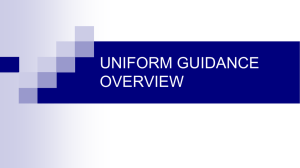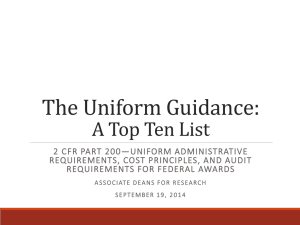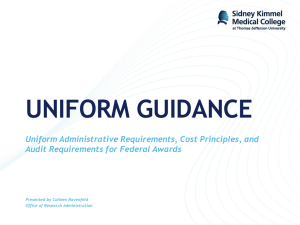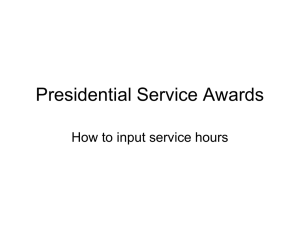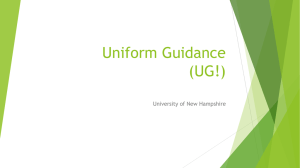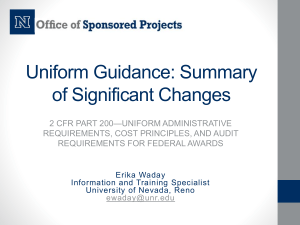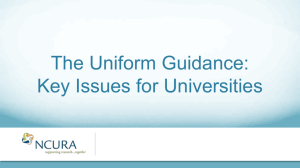MALPH Super Circular Presentation - Michigan Association for Local
advertisement
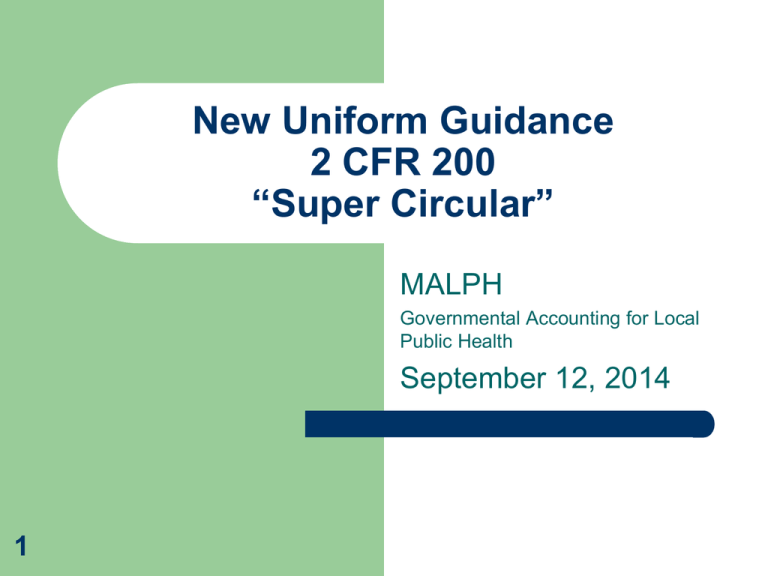
New Uniform Guidance 2 CFR 200 “Super Circular” MALPH Governmental Accounting for Local Public Health September 12, 2014 1 Presented By: Deb Hallenbeck MDCH Office of Audit 517-241-7598 hallenbeckd@michigan.gov 2 Outline 3 Process Intent Applicability Effective Dates Final Product/Layout Changes / Items Worth Mentioning 2 CFR 200: Uniform Administrative Requirements, Cost Principles and Audit Requirements for Federal Awards AKA “Super Circular” AKA “Omni Circular” Not a Circular Federal Regulation Located at: Federal Register: http://www.gpo.gov/fdsys/pkg/FR-2013-12-26/pdf/2013-30465.pdf Electronic CFR: http://www.ecfr.gov/cgi-bin/text-idx?tpl=/ecfrbrowse/Title02/2cfr200_main_02.tpl 4 Process Presidential Executive Order (2009) and Memorandum (2011) Create a more streamlined and accountable structure to coordinate financial assistance COFAR created (2011) Improve delivery, mgt, coordination, accountability of Federal grants OMB issued Advance Notice on Potential Reforms 2/28/2012 OMB issued Draft Proposal 2/1/2013 5 OMB published New Uniform Guidance (Final) 12/26/2013 (Federal Agencies to submit implementing regs by 6/26/14) Intent Consolidate 8 existing Circulars - Administrative Requirements (A-102, A-110, A-89) - Cost Principles (A-21, A-87, A-122) - Audit Requirements (A-133, A-50) 6 Eliminate duplicative and conflicting provisions Clarify where policies are uniform Highlight differences that exist among entities Modify some existing requirements Applicability / Who Impacted Federal Agencies Non-Federal Entities (defined 200.69) States, local governments, Indian tribes, institutions of higher ed, and non-profits Receive Federal Awards Recipient or Subrecipient Their Auditors Limited Exceptions are at 200.101-.102 7 Effective Dates (200.110) Grant Administration 12/26/2014 - New grants 1/1/2015 and after - If both old and new awards, may change entity-wide policies (e.g. procurement and payroll) to comply with new requirements – not penalized for doing so 8 Single Audits Fiscal Years BEGINNING on or after 12/26/2014 - Fiscal Year 1/1/15 – 12/31/15 - May not early implement Final Product / Layout (By Subpart) A. B. C. D. E. F. 9 Acronyms and Definitions General Provisions Pre-Federal Award Requirements and Contents of Federal Awards Post Federal Award Requirements Cost Principles Audit Requirements Final Product / Layout (By Appendix) I. II. III. IV. V. VI. VII. VIII. IX. X. XI. 10 Notice of Funding Opportunity Contract Provisions Indirect – Higher Eds Indirect – Non-Profits State/Local Central Service Cost Allocation Public Assistance Cost Allocation Plans State/Local/Indian – Indirect Cost Proposals Non Profits Exempt from Cost Principles Hospital Cost Principles Data Collection Form Compliance Supplement Changes / Items Worth Mentioning 11 Financial Management System [200.302(b)] 1. 2. 3. 4. 5. 6. 7. 12 Identification of all Federal awards Current, accurate, complete financial results Records that identify source and use of funds Effective control over and accountability for assets Comparison of expenditures to budgets Written procedures on payments (200.305) Written procedures for determining allowability of costs (Subpart E) New Section on Internal Controls (200.303) Establish and maintain effective internal control over the Federal award that provides reasonable assurance that the non-Federal entity is managing the Federal award in compliance with Federal statutes, regulations, and the terms and conditions of the Federal award. (References guidance by Comptroller General and COSO) 13 Evaluate and monitor compliance Take prompt action when non-compliance identified Safeguard protected personally identifiable info Property [200.311(real) & .313(equipment)] Title to property purchased with Federal funds rests with non-Federal entity Must be insured Property Records (200.313(d)(1)) Physical inventory every 2 years Disposition – Request instructions 1. Retain & compensate Federal Agency 14 2. Sell & compensate Federal Agency 3. Transfer title to Federal Agency or designated 3rd party New Procurement Standards (200.318-.326) 15 Use documented procurement procedures Maintain oversight Written standards of conduct - No conflicts of interest Most economical purchase option Maintain records on history of procurement Must conduct in a manner providing full and open competition Methods (Next slide) Procurement Methods (200.320) Must use one of the following methods: 1. Micro (aggregate < $3,000) No soliciting competitive quotations 2. Small (< $150,000) Price quotes required from “adequate” number of qualified sources 3. Sealed bids/competitive proposals (> $150,000) Cost/price analysis required 16 (Noncompetitive Proposals permitted in certain circumstances) Monitoring & Reporting Performance (200.328) 1. 2. 3. 17 Must monitor activities to assure performance expectations met Must submit performance reports – intervals as required by Feds or pass-through entity “OMB-approved government-wide standard information collections”…reports to contain: Compare actual accomplishments to objectives Reasons goals not met Additional pertinent information (e.g. cost overruns) Subrecipient vs. Contractor (old term – Vendor) Subrecipient (Subaward) Carrying out a program/portion of a Federal award Programmatic decision making (200.330 for determinations) 18 Contractor (Contract) Providing goods or services that are ancillary to the operation of the Federal program Provides similar goods or services to many different purchasers Subaward Identified as Such and Include Required Information(200.331a) 19 Subrecipient Name/DUNS number Federal Award Identification Number (FAIN) Award date/period of performance Award amount CFDA number/name Federal awarding agency Project description General and Specific Terms and Conditions Access to records Approved Federally recognized indirect cost rate; or a negotiated rate or a de minimis indirect cost rate of 10% of MTDC (200.414) New Section on Subrecipient Monitoring (200.331b) Evaluate subrecipient risk Experience Results of audits New personnel Results of Federal agency monitoring 20 Consider imposing specific conditions on subrecipients based on risk Monitor subrecipient activities in response to identified risks Remedies for Noncompliance (200.338) 21 May impose additional conditions (200.207) Withhold cash payments Disallow costs not in compliance Suspend/terminate award Initiate suspension and debarment proceedings Withhold further Federal awards Cost Principles – Subpart E Total Cost = Direct + Allocable Indirect – Applicable Credits Basic Guidelines remain unchanged from OMB Circular A-87 (200.403) “Prior Approval” – can ask for prior approval for special or unusual costs. Some items specifically require prior approval. (200.407) Selected Items of Cost – 50+ items included Apply to both direct and indirect costs If not mentioned, doesn’t mean it’s not allowed. Apply general principles of allowability. 22 Federal Award Provisions Govern/Rule Direct Cost Allocation Principles [200.405(d)] If a cost benefits two or more projects or activities in proportions that can be determined without undue effort or cost, the cost should be allocated to the projects based on the proportional benefit. 23 Indirect Cost Rate Proposals and Cost Allocation Plans (200.414) Must accept negotiated rate if there is one Develop and submit indirect cost rate proposal and cost allocation plan as specified in: Appendix V – State/Local Government and Indian TribeWide Central Service Cost Allocation Plans Appendix VII – States and Local Government Indian Tribe Indirect Cost Proposals 24 Any non-Federal entity that has never received a negotiated indirect cost rate (except for those w/ >$35 million in direct Federal) may elect to charge a de minimis rate of 10% MTDC. [200.414(f)] Time and Effort Reporting Documentation Standards [200.430(i)] 25 Broad principles rather than specific examples – “records that accurately reflect the work performed” and internal control providing reasonable assurance (accuracy, allowability, properly allocated) Key principles remain: after-the-fact, full disclosure, timely completion, budget estimates for interim and adjust to actual Substitute systems (random moment sampling, time studies, case counts) require approval by the cognizant agency for indirect cost. [200.430(i)(5)] Conferences (200.432), Employee Welfare (200.437), Relocations (200.464) 26 Language strengthened to appropriately limit allowable costs Exercise discretion and judgment (conferences) “In accordance with documented policies” and dropped references to recreational activities and other specific items (employee welfare) Relocate existing employee and new hire – subject to limitations Depreciation (200.436) 27 Cost of fixed assets allocated to periods benefitting from use Use Allowance – no longer permitted Intellectual Property (200.448) 28 Patent and copyright costs – allowed if required by the Federal award Royalties and other costs for use of patents and copyrights – allowed if necessary for performance of award, and no license currently in existence, and not purchased from a related party Travel (200.474) 29 Documentation must justify that participation of the individual is necessary to the Federal award, and the costs are reasonable and comply with the agency travel policy. Temporary dependent care costs – if direct result of travel, consistent with entity-wide Travel Policy, and temporary during travel Appendix V - State/Local Government and Indian Tribe-Wide Central Service Cost Allocation Plans 30 Assigns centralized County costs (accounting, HR, purchasing, computers, motor pool, administration) to benefitted activities (Health Department). Allocated or billed Major local government (>$100 million direct) submit plan annually to cognizant agency All other locals – develop and maintain plan for audit Appendix VII – States and Local Government Indian Tribe Indirect Cost Proposals Indirect costs – costs incurred for common purpose benefitting more than one cost objective – can’t be readily assigned without effort disproportionate to the results achieved. Includes indirect of Health Department and County central services distributed through the central service CAP. Types of rates defined: Final Rate – based on past actual costs / not subject to adjustment Fixed Rate – based on estimate / difference from actual carried fwd Predetermined Rate – based on estimate / not subject to adjustment Provisional Rate – temporary pending establishment of “Final Rate” 31 Methods explained (simplified, multiple allocation base, special) Documentation and submission requirements >$35 million direct – submit to cognizant agency for indirect All others – retain for audit Single Audits – Subpart F Make Single Audit Reports available on-line Raises threshold from $500,000 to $750,000 (still covers 99% of funds currently covered and eliminates the requirement for about 5,000 entities) 32 Raises threshold for an auditor to report questioned costs from $10,000 to $25,000 Major Program determination changes Management decision issued within 6 months of acceptance of audit report by FAC Online Resources 33 www.cfo.gov/wp-content/uploads/2013/01/2-C.F.R.-200-FAQs-2-12-2014.pdf www.cfo.gov/cofar www.whitehouse.gov/omb/grants (select grant reform) www.whitehouse.gov/omb/financial_default/ (OMB Office of Federal Financial Management) Questions Deb Hallenbeck 517-241-7598 hallenbeckd@michigan.gov 34
